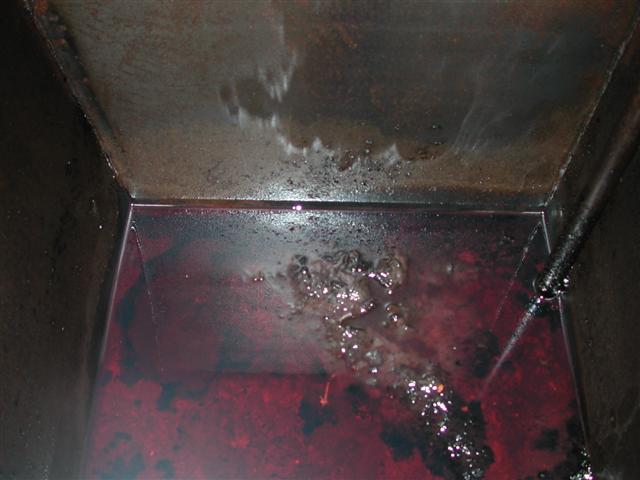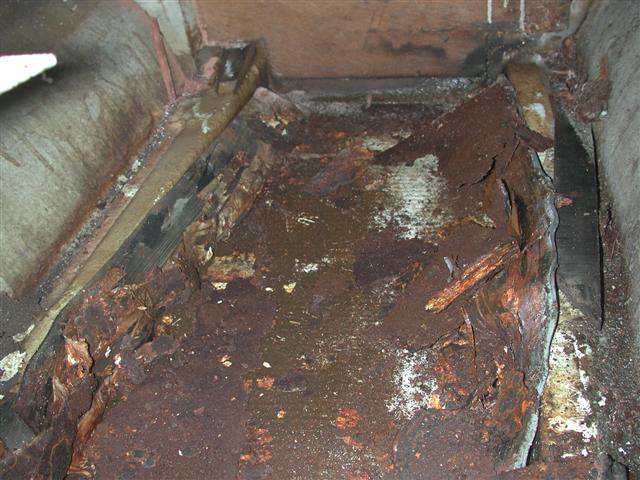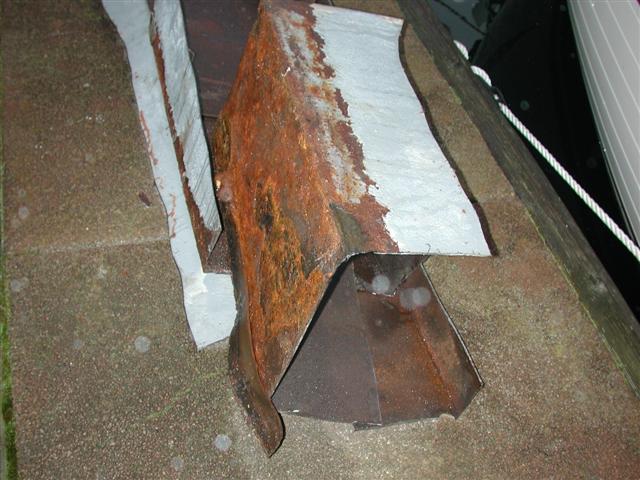Was this Really necessary?
In a word, YES. The old tank was compromised and would have leaked eventually. Prior to removing the old tank an internal inspection revealed an undamaged interior. Due to the defects in the tank installation the tank was rotting from the bottom and sides, areas not available for inspection.
I truly believe this was an inevitable job and I'm glad we chose to do it before it blew our budget while cruising. I've heard mixed opinions on this from other people who've done this job on a Baba 40, but the key point is none of us knew for sure until we cut into that old tank.
State of the old tank

While dirty, an inspection of the interior of the old tank did not reveal the extent of the rust damage that was working from the outside.
The old tank was emptied and inspected as best I could from the two inspection ports. The inspection ports allowed access to three of the four sections created by the baffles.

Scale from the front section
The front of the tank had less standing water than the aft section yet still lost this much scale. The amount of scale in the bilge increased as we moved aft.

Bottom of aft section of the old tank
The aft lower section of the tank was missing around 70% of the original wall thickness in spots. The last thing I'd want is for this old tank to start leaking in a few years when we are in the South Pacific.
The most amazing discovery for me was the poor work TaShing did under and around the tank, where the shoddiness could not be seen. There is nothing wrong with properly installed carbon steel fuel tanks, TaShing simply condemned this tank to an early death through improper installation.
How'd we do against our original goals?
- Maintain the original fuel capacity of ~110 gallons (US) - Yes
- Minimize disruption to the finished teak interior during the replacement and for future access. - Yes
- Eliminate known problems with the original installation:
- Provide proper drainage for the bilge area under and around the fuel tank. - Yes
- Adequately protect the tanks from potential corrosion or rust. - Yes
- Correct poor fiberglass work around the old tank that allowed standing water. - Yes
- Provide access to the port side of the tank under the settee. - Yes
- Provide adequate access to wiring and plumbing on the port side of the tank. - Yes
- Allow tank access to all tank segments for cleaning and maintenance without disruption of structural members or major equipment. - Yes
- Allow inspection of the exterior of the tank without disruption of structural members. - Yes
- Provide mechanical means of determining fuel level. - Yes
- Provide electrical means of determining fuel level and setting level alarms. - Yes
- Allow re-fueling at appropriate flow rate. - Yes
- Minimize number of fuel tanks, preferably no more than two storage tanks plus one day tank. - No
- Provide a day tank isolated from storage tanks. - Yes
- Provide a fuel filtering system independent of the fuel system on the main engine. - Yes
We mostly met our goals, not bad considering the difficulties involved.
What would I do differently?
Honestly, not a lot. I'd give up a few gallons of capacity and decrease the height of the first three tanks somewhere between 1/2' - 1" to eliminate some of the installation difficulties due to low clearance between the tank tops and the floor framing. The other thing I'd do differently is design additional floor supports into the job when planning the tank configuration. The floor supports I put between tanks will have to be augmented with additional supports on each side of the new tanks.
I'm very happy with the results and have achieved most of the goals set at the beginning of the project. Five total tanks is an acceptable trade-off to tearing up the interior, and I like the capability of removing all of them without other major work.
2006 Update
I think I'd look into creating a fiberglass tank in the bilge by glassing in two ends and baffles and making a fiberglass top and glassing that in place. The biggest difficulty would be glassing in both sides of the top. This would make a single, integrated tank with out all the issues we had trying to secure and plumb tanks in the bilge. You'd have more capacity and a lot more extra space left over. There are many production boats that use fiberglass tanks, I think they'd be hard to beat for longevity.
Back to Plumbing Page
Back to Main Refit Page



